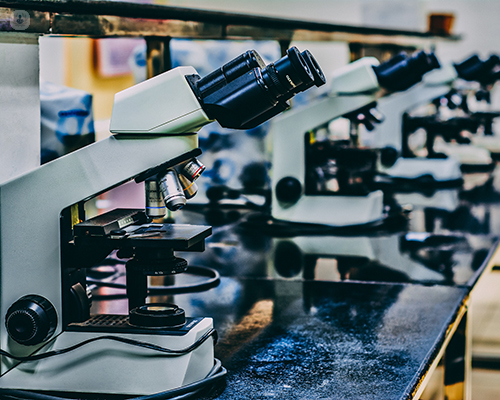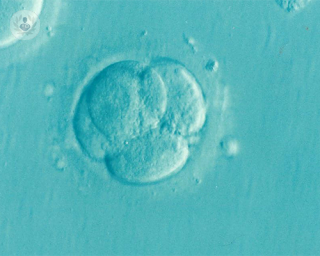What is preimplantation genetic diagnosis (PGD)?
Preimplantation genetic diagnosis (PGD) is a technique used to detect genetic diseases or defects in embryos being used for in vitro fertilisation (IVF) before they are implanted in the uterus. Following advice from a fertility specialist, PGD might be offered to a couple that may know of genetic disorders running in their families, or to test the risk of genetic disease in the embryo. If PGD test results show that an embryo is at risk of genetic disease, then the couple can choose to not implant that embryo.

What does PGD consist of?
The first phase of PDG involves ovarian stimulation to induce the maturation of several follicles and thus a greater number of oocytes. Next, the oocytes are collected transvaginally, using ultrasound. A microneedle is inserted into the vagina to harvest the mature ovules. These are then sent to the laboratory, examined under a microscope and, using high precision tools, a single sperm is inserted into the oocyte (in vitro fertilisation).
The next phase involves the biopsy of an embryo (removal of a cell, called a blastomer, from the embryo) to perform a genetic analysis. This phase is the most important part of the preimplantation genetic diagnosis process and for this reason it must be done with reliable procedures and tools. Finally, after performing the analysis in the examined cells, only embryos that have not presented mutations during the examination are inserted into the patient.
What do you feel during the exam?
Preimplantation genetic diagnosis (PGD) is a painless procedure that does not require anaesthesia or sedation as the testing is done in a laboratory setting.
06-30-2015 07-07-2023Preimplantation Genetic Diagnosis
Dr Muhammad Fatum - Fertility specialist
Created on: 06-30-2015
Updated on: 07-07-2023
Edited by: Sophie Kennedy
What is preimplantation genetic diagnosis (PGD)?
Preimplantation genetic diagnosis (PGD) is a technique used to detect genetic diseases or defects in embryos being used for in vitro fertilisation (IVF) before they are implanted in the uterus. Following advice from a fertility specialist, PGD might be offered to a couple that may know of genetic disorders running in their families, or to test the risk of genetic disease in the embryo. If PGD test results show that an embryo is at risk of genetic disease, then the couple can choose to not implant that embryo.

What does PGD consist of?
The first phase of PDG involves ovarian stimulation to induce the maturation of several follicles and thus a greater number of oocytes. Next, the oocytes are collected transvaginally, using ultrasound. A microneedle is inserted into the vagina to harvest the mature ovules. These are then sent to the laboratory, examined under a microscope and, using high precision tools, a single sperm is inserted into the oocyte (in vitro fertilisation).
The next phase involves the biopsy of an embryo (removal of a cell, called a blastomer, from the embryo) to perform a genetic analysis. This phase is the most important part of the preimplantation genetic diagnosis process and for this reason it must be done with reliable procedures and tools. Finally, after performing the analysis in the examined cells, only embryos that have not presented mutations during the examination are inserted into the patient.
What do you feel during the exam?
Preimplantation genetic diagnosis (PGD) is a painless procedure that does not require anaesthesia or sedation as the testing is done in a laboratory setting.


What happens exactly in chromosome translocations?
By Mr Mahantesh Karoshi
2025-02-09
In this article, highly regarded consultant gynaecologist, Mr Mahantesh Karoshi, explains what happens exactly in chromosome translocations, and reveals whether or not a woman's chances of suffering a miscarriage can be increased depending on whether or not one of the parents have a balanced chromosome translocation. See more


FAQs: in vitro fertilisation (IVF) – part 2
By Dr Benjamin Abramov
2025-02-08
In vitro fertilisation is a form of fertility treatment that can help women to get pregnant. Dr Benjamin Abramov, a leading fertility specialist, answers some more frequently asked questions about IVF, following on from part one. See more


How does pre-implantation genetic screening (PGS) work?
By Dr Benjamin Abramov
2025-02-08
Having a baby is not always straightforward. Genetics and infertility can conspire to make starting a family seem like an impossibility. However, options such as IVF can help to maximise your chances. One such option is pre-implantation genetic screening (PGS), which can help to streamline the IVF process. Fertility specialist Dr Benjamin Abramov explains. See more
Experts in Preimplantation Genetic Diagnosis
-
Professor Yacoub Khalaf
Obstetrics & gynaecologyExpert in:
- Infertility
- Assisted reproductive technology
- Preimplantation Genetic Diagnosis
- Recurrent miscarriage
- Fibroids
- Polycystic ovary syndrome (PCOS)
-
Dr Benjamin Abramov
Fertility specialistExpert in:
- Assisted reproductive technology
- Fertility test
- Egg freezing
- Recurrent miscarriage
- Preimplantation Genetic Diagnosis
- Egg donation
-
Dr Muhammad Fatum
Fertility specialistExpert in:
- In vitro fertilisation (IVF)
- Minimal access surgery (keyhole surgery)
- Preimplantation Genetic Diagnosis
- Fertility Preservation
- Reproductive immunology
-
Dr Mohamed Mohamed
Fertility specialistExpert in:
- Endometriosis
- Reproductive immunology
- Preimplantation Genetic Diagnosis
- Polycystic ovary syndrome (PCOS)
- Male infertility
- Infertility
- See all

London Bridge Hospital - part of HCA Healthcare
London Bridge Hospital - part of HCA Healthcare
27 Tooley St
No existe teléfono en el centro.
By using the telephone number provided by TOP DOCTORS, you automatically agree to let us use your phone number for statistical and commercial purposes. For further information, read our Privacy Policy
Top Doctors

Guy’s and St Thomas’ Private Healthcare
Guy’s and St Thomas’ Private Healthcare
Guy’s Hospital, Great Maze Pond
No existe teléfono en el centro.
By using the telephone number provided by TOP DOCTORS, you automatically agree to let us use your phone number for statistical and commercial purposes. For further information, read our Privacy Policy
Top Doctors
-
London Bridge Hospital - part of HCA Healthcare
27 Tooley St, Central LondonExpert in:
- 24-hour service
- Cardiology
- Minimal access surgery (keyhole surgery)
- Orthopaedic surgery
- Cardiovascular disease
- Gastroenterology
-
Guy’s and St Thomas’ Private Healthcare
Guy’s Hospital, Great Maze Pond, SE1 South Bank LondonExpert in:
- Allergy
- Cardiology
- General Surgery
- Maxillofacial Surgery
- Thoracic Surgery
- Maternity care
- See all
- Most viewed diseases, medical tests, and treatments
- Polycystic ovary syndrome (PCOS)
- Osteoporosis
- Menopause support
- PGT-M
- Tubal factor infertility
- PGT-A
- Complex endometriosis
- Fertility preservation
- Female infertility
- Ovulatory disorders





